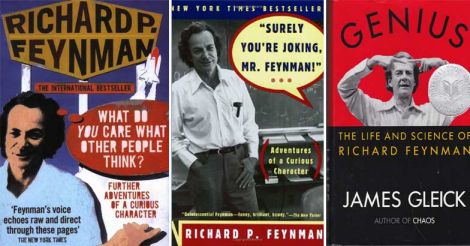Scientists are perceived as absent-minded geniuses on some exalted plane of existence, oblivious to their appearance or ordinary matters in their quest to understand and explain the mysteries of nature. Perhaps that is why their lives are more recounted in a biography than autobiography - which most never got around to writing or wouldn't have been very intelligible to laymen. But exceptions always exist - like this gifted but very irreverent theoretical physicist - who learnt how to crack safes, played bongo drums, frequented topless bars and eventually won the Nobel Prize!
Richard P. Feynmann (1918-88) was one of the most well-known scientists in his time, described by a contemporary as "both genius and buffoon" as well as figuring in the "holy trinity" of 20th century physics along with Albert Einstein and Stephen Hawking.
In " 'Surely You're Joking, Mr. Feynman!': Adventures of a Curious Character" (1985) and " 'What Do You Care What Other People Think?': Further Adventures of a Curious Character" (1988), he shares with us his life and illustrious career which included participation in the Manhattan project (the American development of the atom bomb during World War II - and this was where he learnt to crack safes and give his colleagues near heart-attacks!) and in the panel probing the Challenger space shuttle crash - whose cause he simply explained by dropping a rubber clamp in ice water!
The books also seek to explain his work in quantum mechanics, quantum electrodynamics (for which he received the Nobel Prize in 1965), quantum computing and the concept of nanotechnology as well as his role in popularising physics, for a better education system fostering understanding over rote learning, the importance of curiousity and experimentation and the scientist's responsibility to society.
And, yes, Feynman did more than anyone else to break the stereotype of a scientist as a studious figure in thick glasses.
To these ends were his varied escapades- described with relish and wit - including getting into a fight in the men's room of a bar (earning a black eye in the process), painting (including of nudes such as of Marie Curie based on his contention that people don't think of the great scientist as a woman but just focus on the radium part - which led him to face the tough question how he got her to pose for him), playing an instrument in a samba band in Brazil (in the carnival!), his insistence on getting an actual dollar for transferring his patent to the government, and experiments about consciousness - including with hypnotism (in college) and latter with LSD and in a sensory deprivation tank.
Feynman was however not the first famous scientist to write about his life, being preceded by Einstein's (posthumous) "Autobiographical Notes" (1979). But Einstein's is a "near-autobiography" - a personal account, no doubt, by the greatest and well-known scientist but focussing more about the development of his ideas, and little about his private life or about the events of his times.
Feynman's books - though, strictly speaking, not autobiographies but collections of short and long autobiographical anecdotes - are among the first in which a physicist talks about his personal life, his childhood, his aspirations and motivations, his work and plenty about his exploits, most of which verge on being high-spirited pranks.
Their accessible nature owes something to their genesis - they arose out of expansive, free-ranging conversations Feynman, an enthusiastic drummer, had with his friend and drumming partner, Ralph Leighton. Leighton, the son of Caltech physicist and Feynman's close personal friend Robert Leighton, recorded the narration, releasing some as The Feynman Tapes - which became the basis for both the books.
The first book's question arises out of an incident involving the newly-arrived, socially-inept Feynman at a tea party at Princeton. It was the response by the dean's wife, who asking Feynman if he wanted cream or lemon in his tea, was told "both". Feynman says he learnt this was an indication he had made a social gaffe! But it didn't stop him ever in his life - even getting an argument with a princess at a Nobel award dinner who said he couldn't talk about physics since no one there knew about it.
The second book's question owes from the line his first wife Arline Greenbaum (whom he married despite knowing she was dying of TB) used to convince him to do her bidding.
It is these touches which reveal scientists are no less human!



































































































































































































































































































.jpg.image.160.84.jpg)





































































































































.jpg.image.160.84.jpg)










































 The books on Richard P. Feynmann
The books on Richard P. Feynmann
Disclaimer
The comments posted here/below/in the given space are not on behalf of Manorama. The person posting the comment will be in sole ownership of its responsibility. According to the central government's IT rules, obscene or offensive statement made against a person, religion, community or nation is a punishable offense, and legal action would be taken against people who indulge in such activities.